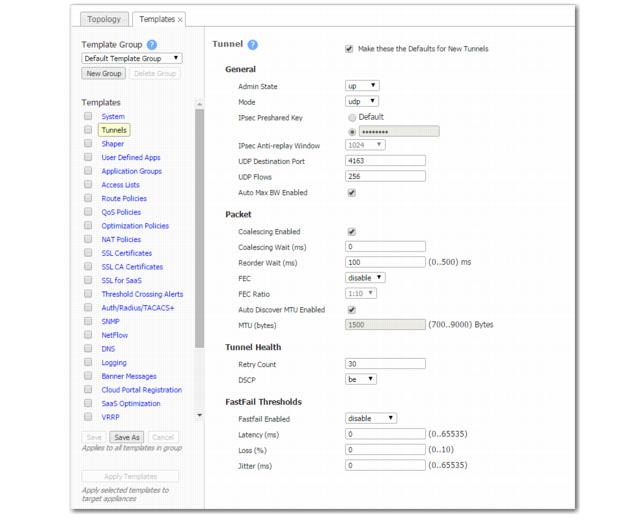Use this template to assign and manage tunnel properties.
|
n
|
|
n
|
Applying tunnel templates does not create new tunnels. To create tunnels, use the Tunnel Builder tab.
|
|
n
|
|
n
|
|
n
|
Auto Discover MTU Enabled allows an appliance to determine the best MTU to use.
|
|
n
|
Auto Max BW Enabled allows the appliances to auto-negotiate the maximum tunnel bandwidth.
|
|
n
|
Coalescing Enabled allows the appliance to coalesce smaller packets into larger packets.
|
|
n
|
Coalescing Wait (ms) is the number of milliseconds that the appliance should hold packets while attempting to coalesce smaller packets into larger ones.
|
|
n
|
DSCP determines which DSCP marking the keep-alive messages should use.
|
|
n
|
Fastfail Thresholds – When multiple tunnels are carrying data between two appliances, this feature determines how quickly to disqualify a tunnel from carrying data.
|
|
•
|
Fastfail Enabled – This option is triggered when a tunnel's keepalive signal doesn't receive a reply. The options are disable, enable, and continuous. If the disqualified tunnel subsequently receives a keepalive reply, its recovery is instantaneous.
|
|
•
|
If set to disable, keepalives are sent every second, and 30 seconds elapse before failover. In that time, all transmitted data is lost.
|
|
•
|
If set to enable, keepalives are sent every second, and a missed reply increases the rate at which keepalives are sent from 1 per second to 10 per second. Failover occurs after 1 second.
|
|
•
|
When set to continuous, keepalives are continuously sent at 10 per second. Therefore, failover occurs after one tenth of a second.
|
|
•
|
|
n
|
|
n
|
FEC Ratio is an option when FEC is set to auto, that specifies the maximum ratio. The options are 1:2, 1:5, 1:10, or 1:20.
|
|
n
|
IPSec Anti-replay window provides protection against an attacker duplicating encrypted packets by assigning a unique sequence number to each encrypted packet. The decryptor keeps track of which packets it has seen on the basis of these numbers. The default window size is 64 packets.
|
|
n
|
IPSec Preshared Key is a shared, secret string of Unicode characters that is used for authentication of an IPSec connection between two parties.
|
|
n
|
Mode determines whether the tunnel is udp, gre, or ipsec. If used, IPSec must be enabled at both ends of the tunnel.
|
|
n
|
MTU (bytes) (Maximum Transmission Unit) is the largest possible unit of data that can be sent on a given physical medium. For example, the default MTU of Ethernet is 1500 bytes. Silver Peak provides support for MTUs up to 9000 bytes.
|
|
n
|
Reorder Wait (ms) is the number of milliseconds to allow for out-of-order packets to reorder. The default value is 100 ms.
|
|
n
|
Retry Count is the number of failed keep-alive messages that are allowed before the appliance brings the tunnel down.
|
|
n
|
UDP destination port is used in UDP mode. Accept the default value unless the port is blocked by a firewall.
|
|
n
|
UDP flows is the number of flows over which to distribute tunnel data. Accept the default.
|

